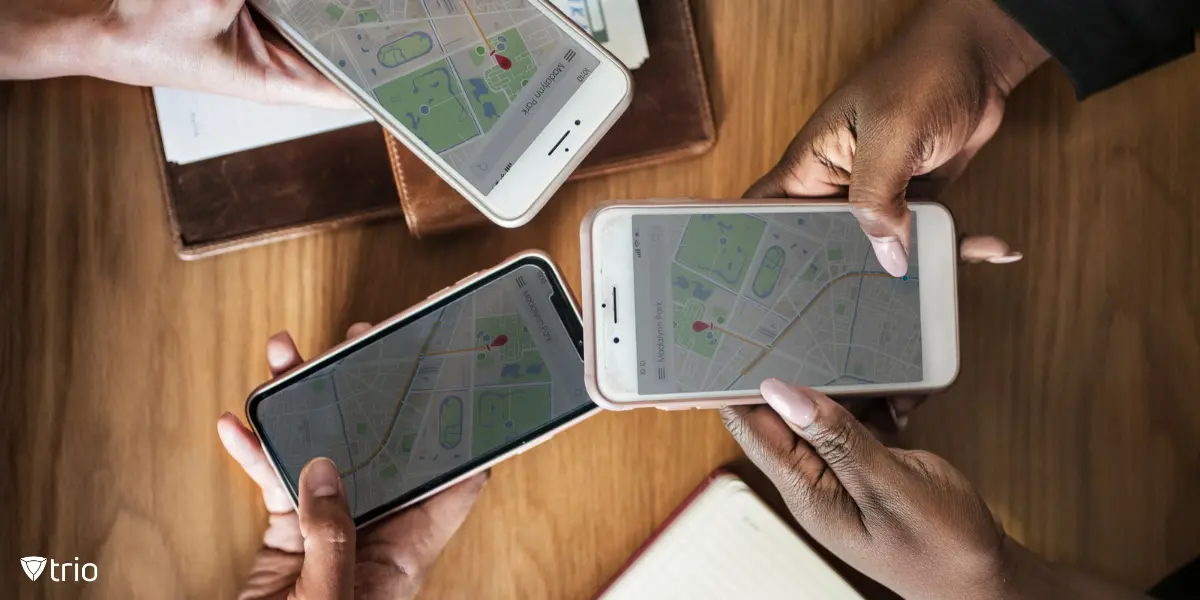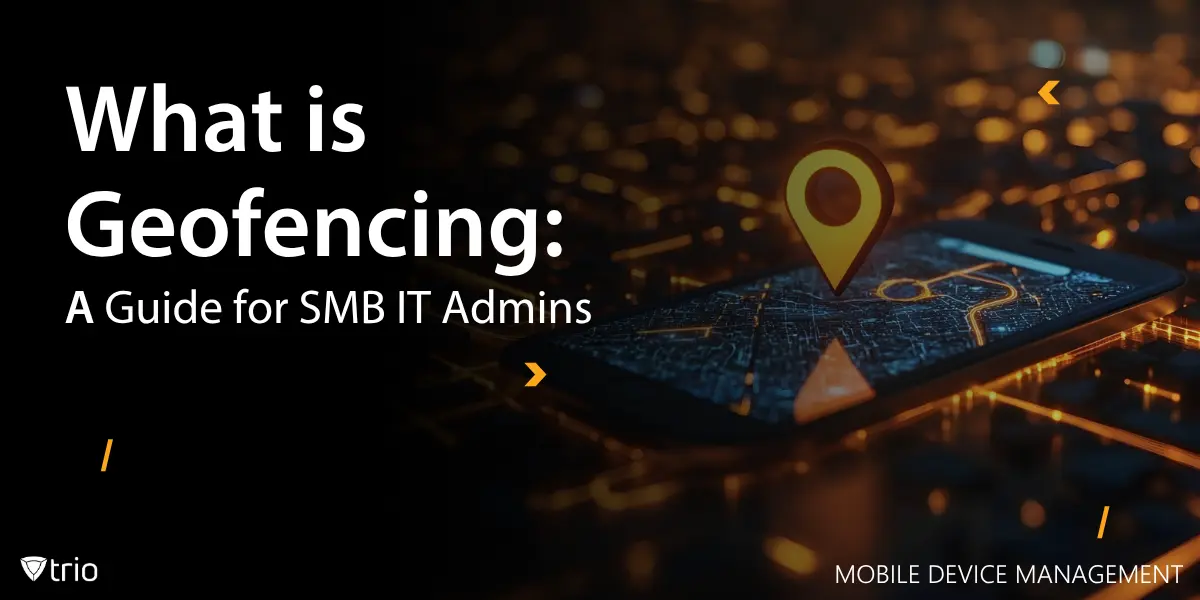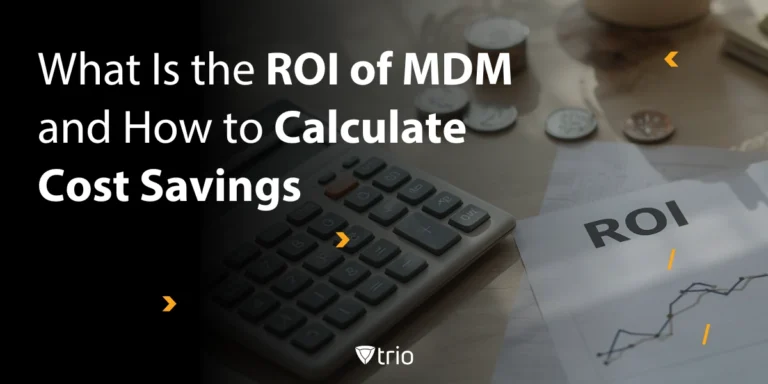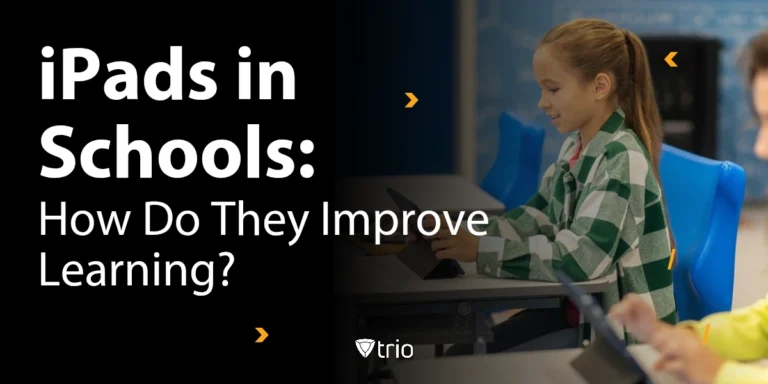As an IT administrator at a small or medium-sized business (SMB), you’re tasked with securing devices, ensuring compliance, and keeping operations running smoothly—all while juggling limited resources. With remote work, bring-your-own-device (BYOD) policies, and distributed teams becoming the norm, managing devices across various locations adds another layer of complexity. Enter geofencing, a powerful tool that’s transforming how SMBs manage their device fleets. But what is geofencing, and how can it benefit your organization? In this comprehensive guide, we’ll explore the ins and outs of geofencing, its practical applications for SMBs, and why Trio MDM is the perfect solution to implement it effectively. By the end, you’ll understand how geofencing can streamline your IT operations.
What is Geofencing?
Geofencing is a location-based technology that creates virtual boundaries around a specific geographic area using GPS, RFID, Wi-Fi, or cellular data. When a device enters or exits these predefined boundaries, the geofencing system triggers specific actions, such as sending alerts, enforcing policies, or restricting access. Think of it as an invisible fence that helps IT admins monitor and control devices based on their physical location.
For SMBs, geofencing is typically integrated into Mobile Device Management (MDM) solutions, allowing IT teams to enforce security policies, manage compliance, and enhance productivity across a distributed workforce. Whether you’re securing sensitive data in an office, restricting app access outside work premises, or tracking company devices, geofencing provides a flexible and automated way to maintain control.
Types of Geofencing
Geofencing can be implemented in two primary ways, each with distinct characteristics that impact performance and use cases for SMBs:
| Type | How It Works | Pros | Cons | Best For |
|---|---|---|---|---|
| Active | Frequent GPS polling | High precision outdoors | More battery use | Field, logistics, asset tracking |
| Passive | Wi-Fi/cellular "significant change" | Battery-friendly | Less precise indoors | Offices, BYOD, low-friction rollouts |
How Geofencing Works
Geofencing operates through a clear, step-by-step process that integrates with MDM solutions to deliver automated control:
- Define the Boundary: IT admins use an MDM platform to create virtual geofences by specifying geographic coordinates, addresses, or a radius around a location (e.g., an office or warehouse). These boundaries can be circular or polygonal, depending on the use case.
- Monitor Device Position: Devices equipped with GPS, Wi-Fi, or cellular capabilities continuously or periodically report their location to the MDM system, depending on whether active or passive geofencing is used.
- Detect Entry, Exit, or Dwell: The system detects when a device enters, exits, or remains (dwells) within the geofenced area. For example, dwelling detection can trigger actions if a device stays in a restricted zone too long.
- Trigger Actions: Based on the detection, the MDM executes predefined actions, such as sending alerts to IT admins, locking the device, restricting app access, or logging compliance data for analytics.
For SMBs, this process is managed through a centralized MDM dashboard, like Trio’s, which provides real-time insights and simplifies configuration. For instance, an SMB could set a geofence around a client site to ensure devices only access sensitive data while onsite, with automatic restrictions applied upon exit.
Benefits of Geofencing for SMBs
Geofencing offers a range of advantages for SMBs, particularly those with limited IT staff and budgets. Here’s how it can transform your device management strategy:
1. Enhanced Security
Geofencing strengthens security by restricting access to sensitive data or applications based on location. For instance, you can configure devices to access corporate resources only when within a secure office environment. If a device is taken outside the geofence (e.g., a stolen laptop), the MDM can lock it or wipe sensitive data remotely, protecting your organization from breaches.
2. Improved Compliance
For SMBs in regulated industries like healthcare or finance, geofencing ensures compliance with data protection laws. By limiting where devices can access sensitive information, you reduce the risk of non-compliance. For example, a healthcare SMB could use geofencing to ensure patient data is only accessible within a clinic, aligning with HIPAA requirements.
3. Streamlined BYOD Management
With BYOD policies, separating personal and corporate data is a challenge. Geofencing allows you to enforce policies only when devices are in work-related locations, preserving employee privacy outside those areas. For instance, you could restrict corporate email access to the office while allowing personal apps to function freely elsewhere.
4. Increased Productivity
Geofencing can boost employee productivity by automating device configurations. For example, when employees enter the office, their devices can automatically connect to secure Wi-Fi, enable work apps, or disable distracting features like social media. This reduces manual setup time and keeps employees focused.
5. Cost Efficiency
For SMBs with lean IT teams, geofencing automates repetitive tasks like policy enforcement and device monitoring, reducing the need for manual intervention. This saves time and lowers operational costs, allowing your team to focus on strategic priorities.

Practical Use Cases for SMBs
Geofencing is versatile and can be tailored to a variety of SMB scenarios, enhancing security, efficiency, and engagement:
- Office-Based Security: Restrict access to corporate apps or data to office premises, ensuring sensitive information stays secure. For example, a financial SMB can limit access to accounting software to the office geofence.
- Field Workforce Management: Track and manage devices used by remote or field employees, such as delivery drivers or sales reps, to ensure route compliance and monitor authorized areas. Geofencing can alert admins if a driver deviates from a delivery route.
- Lost or Stolen Device Protection: Automatically lock or wipe devices that leave a designated geofence, minimizing data breach risks for company-owned devices.
- Location-Based Marketing: For SMBs with customer-facing operations, like retail or hospitality, geofencing can push location-based promotions to employee or customer devices within a store’s vicinity, boosting engagement.
- Fleet and Logistics: Monitor company vehicles or equipment to ensure they stay within operational zones, improving logistics efficiency and reducing unauthorized use.
- IoT and Automation: Integrate geofencing with IoT devices, such as smart office equipment, to trigger actions like powering on systems when employees enter the workplace.
- Event-Specific Policies: Set temporary geofences for company events or offsite meetings to enforce specific security settings during those periods.
These use cases demonstrate geofencing’s flexibility, making it a valuable tool for SMBs across industries, from retail to professional services.
Challenges of Implementing Geofencing
While geofencing is powerful, it’s not without challenges. SMBs should be aware of:
- Accuracy Issues: GPS-based geofencing can be less accurate indoors or in areas with poor signal strength, potentially causing false triggers.
- Battery Drain: Continuous location tracking may impact device battery life, though modern MDM solutions optimize this.
- Privacy Concerns: Employees may resist location tracking, especially on BYOD devices. Clear communication and privacy-respecting policies are essential.
- Setup Complexity: Configuring geofences requires careful planning to avoid overly restrictive or ineffective boundaries.
Privacy & Compliance Considerations
Geofencing involves location tracking, which raises important privacy and compliance concerns, especially for SMBs with BYOD policies or operating in regulated industries. To implement geofencing responsibly, consider the following:
- Legal Requirements: Location tracking is subject to regulations like GDPR (in Europe) or CCPA (in California). Ensure your geofencing policies comply with local data protection laws, particularly regarding employee monitoring.
- User Consent: Obtain explicit consent from employees before enabling geofencing, especially on personal devices. Clearly communicate what data is collected and how it will be used.
- Data Anonymization: Where possible, anonymize location data to protect user privacy while still enabling geofencing functionality.
- Transparency Strategies: Maintain open communication with employees about geofencing policies. Provide documentation and training to explain how geofencing enhances security without compromising personal privacy.
What to Look For in a Cost-Effective SMB MDM
- Unlimited geofences (avoid per-fence fees that inhibit adoption).
- Prebuilt policy templates (e.g., POS mode, clinic camera policy) to speed rollout.
- Privacy controls (explicit consent flows, event-only logging, retention settings).
- Battery-aware modes (passive-first, adaptive GPS intervals).
- Policy stacking & group targeting (BYOD vs COBO, roles, risk tiers).
- Queued actions for offline devices (apply on reconnect).
- Audit-ready reporting (one-click CSV/PDF exports).
- Straightforward pricing that scales with your fleet.
Why Trio MDM is the Ideal Geofencing Solution for SMBs
While many MDM platforms support geofencing, Trio MDM stands out for its simplicity, affordability, and SMB-focused features. Designed for IT admins with limited time and resources, Trio makes geofencing accessible and effective, even for small teams managing diverse device ecosystems.
Key Features of Trio MDM
- Easy Geofencing Setup: Create and manage geofences with an intuitive interface, no advanced technical skills required.
- Cross-Platform Support: Apply geofencing to Windows, macOS, iOS, and Android devices, ensuring flexibility for BYOD or company-owned fleets.
- Customizable Triggers: Set specific actions (e.g., lock, notify, or restrict apps) when devices enter or exit geofences.
- Real-Time Monitoring: Get instant alerts and detailed reports on device locations and compliance status via Trio’s centralized dashboard.
- Privacy-First Approach: Respect employee privacy with policies that separate personal and corporate data, especially for BYOD scenarios.
- Affordable Pricing: Unlike complex enterprise MDMs, Trio offers transparent pricing with unlimited device support, perfect for growing SMBs.
Conclusion
Geofencing is a game-changer for SMB IT admins, offering a smart way to enhance security, ensure compliance, and boost productivity across distributed device fleets. By creating virtual boundaries, geofencing automates device management tasks, saving time and reducing risks. While challenges like accuracy and privacy concerns exist, a robust MDM like Trio MDM makes implementation seamless, affordable, and tailored to SMB needs.
Don’t let device management overwhelm your IT team. With Trio MDM, you can unlock the full potential of geofencing and more. Try Trio’s free trial or schedule a free demo today to see how it can transform your operations. Take the first step toward smarter, location-aware device management!
Frequently Asked Questions
Geofencing creates virtual boundaries using GPS/Wi-Fi to trigger actions when devices enter/exit areas. For SMBs, it automates:
- Security policies (e.g., disable cameras in sensitive zones)
- Compliance controls (e.g., restrict data access to office premises)
- Workflow optimizations (e.g., auto-connect to office Wi-Fi
Yes. Modern MDMs like Trio use privacy-first approaches:
- Separate work/personal profiles (only track work apps)
- User consent requirements (opt-in for location tracking)
- Dwell-time triggers (avoid constant GPS pings)
Trio simplifies geofencing with:
✅ Drag-and-drop boundary setup (no coding)
✅ Prebuilt policy templates (HIPAA/retail/education)
✅ Battery-optimized tracking (passive Wi-Fi/Cellular mode)
Automated device locking for stolen/lost devices. Example:
- Set a geofence around your office.
- If a laptop leaves the zone, Trio auto-locks it or wipes sensitive data.
- Saves $20K+ in potential breach costs (per IBM’s 2023 report).
It depends:
GPS: ~5-10m outdoors (best for field teams)
Wi-Fi/Cellular: ~50-100m indoors (sufficient for offices)
Pro tip: Combine both in Trio for balanced precision/battery life.
Get Ahead of the Curve
Every organization today needs a solution to automate time-consuming tasks and strengthen security.
Without the right tools, manual processes drain resources and leave gaps in protection. Trio MDM is designed to solve this problem, automating key tasks, boosting security, and ensuring compliance with ease.
Don't let inefficiencies hold you back. Learn how Trio MDM can revolutionize your IT operations or request a free trial today!





